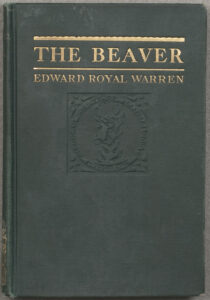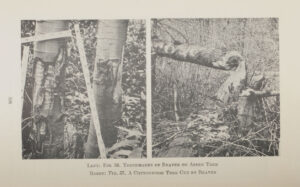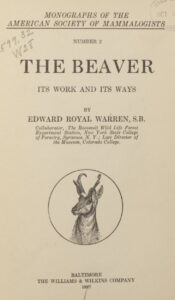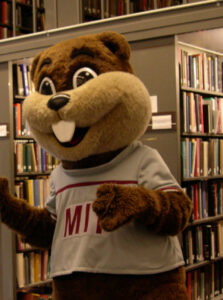Upon graduating from MIT in 1881, Edward Royal Warren left his native Massachusetts and headed west to the silver fields and mining camps of Colorado. He worked for 20 years as an engineer, all the while observing Colorado’s wildlife. Around 1900, he began to devote himself entirely to natural history. In the 40 years that followed, this “amateur” became the foremost authority on Colorado’s mammals, writing the two go-to books on the subject, in addition to publishing nearly 100 articles on mammals and birds.
One indication of the esteem in which his colleagues held Warren is the number of living things they named after him, adding “warreni” to the species names of a marmot, a cottontail rabbit, a wood rat, an evening grosbeak, a lovely white-flowered azalea, and a gall insect.
And what was Warren’s favorite animal? Like any good MIT alum, he was most attracted to the beaver. MIT had adopted the beaver as its mascot in 1914 for its engineering skills and industrious habits, and these are undoubtedly the qualities that compelled Warren to publish The Beaver: Its Work and Its Ways in 1927.
For those who have given little thought to the ways of the beaver, Warren’s tome will answer any question that might come to mind. How many beavers work on cutting down a single tree? Usually one. Do they warn other beavers by slapping their tails when a tree is falling? Sometimes. Why do they build dams? It’s complicated. (The book’s longest chapter is about dams.) What is their favorite food? Above all, beavers prefer to dine on the inner layer of the bark of aspen trees.
 The Beaver addresses all the topics you’d expect to find in a scientific monograph (anatomy, evolution, geographical distribution, etc.), but clearly Warren most enjoyed reporting first-hand observations and debunking myths.
The Beaver addresses all the topics you’d expect to find in a scientific monograph (anatomy, evolution, geographical distribution, etc.), but clearly Warren most enjoyed reporting first-hand observations and debunking myths.
His final chapter is entitled “Things That a Beaver Does Not Do.” In a paean to the creature’s time-management skills, Warren writes, “It is a popular notion that a beaver works all the time. No such thing. He is too wise to do anything so foolish. He works when he has to, and works hard then. But he likes to loaf and play, and I suspect spends a lot of time doing so. Perhaps this goes to show his intelligence.”
And so it is with MIT’s favorite beaver: the school’s mascot, TIM.


